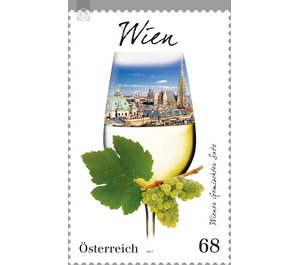wine regions - Austria / II. Republic of Austria 2017 - 68 Euro Cent
Theme: Cuisine & Groceries
| Country | Austria / II. Republic of Austria |
| Issue Date | 2017 |
| Face Value | 68.00 |
| Edition Issued | 350,000 |
| Perforation | 13¾ x 14 |
| Printing Type | offset |
| Stamp Type | Commemorative |
| Item Type | Stamp |
| Chronological Issue Number | 2670 |
| Chronological Chapter | OOS-OE2 |
| SID | 696038 |
| Dimensions | 50.00 x 31.00 |
| In 70 Wishlists | |
The mixed set has tradition. For centuries, different grape varieties have been planted together in Vienna to ensure quality and yield. This special stamp from the series "Wine Regions of Austria" is not about the city itself, but about the wine grown here: The Gemischter Satz - more precisely: the Wiener Gemischter Satz DAC - is the typical wine of the Weinbaugebiet Wien. The stamp motif shows in the wine glass the bright white wine as well as a view of the Viennese city center with the Stephansdom. Vienna is the only major city in the world in which economically relevant viticulture is operated within the city limits. There are approximately 600 hectares of cultivated land in the city, where 80 percent of white wine and 20 percent of red wines are cultivated. More than 20,000 hectoliters of annual wine yield. The growing areas are spread over several districts: in Floridsdorf, Favorites, Liesing, Ottakring, Hernals and Döbling wine is grown, with Döbling is probably the most prominent wine region in Vienna: Grinzing, Kahlenbergerdorf, Nussdorf, Neustift am Walde - here are the most famous wine taverns settled that every tourist visits. A typical Heuriger wine is the Viennese Gemischter Satz, which can advance with appropriate vineyard work and Vinifikation but also in the league really great white wines. Its peculiarity is that it consists of several - just mixed - grape varieties. These are not only "blended" during production (as in a cuvée), but already in the vineyard at least three and up to twenty different white quality grape varieties are planted together and then harvested and processed. Since the Wiener Gemischter Satz received DAC status (Districtus Austriae Controllatus) in 2013, its composition is strictly regulated.


